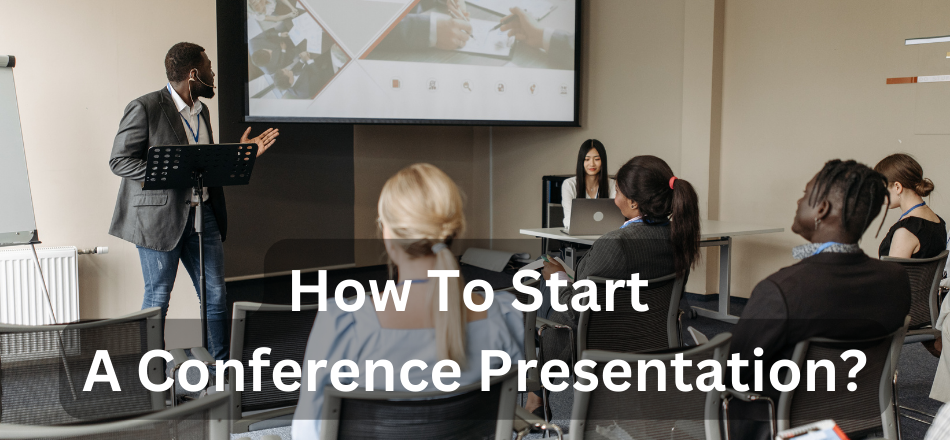Starting a conference presentation can be daunting, especially if you are not accustomed to speaking in front of a large audience. However, with the right preparation and mindset, you can effectively deliver your message and capture your listeners’ attention. So, how to start a conference presentation?
To start a conference presentation, begin with a compelling introduction that captures the audience’s attention, states the purpose of your talk, and provides an overview of what you will cover.
In this article, we will explore the key steps you can take to confidently start a conference presentation and engage your audience from the beginning.
Key Takeaways:
• Preparation and mindset are crucial for delivering an effective conference presentation.
• Tailoring the presentation to the audience’s preferences and interests can increase engagement and retention.
• Crafting an attention-grabbing introduction can capture the audience’s attention and pique their curiosity.
• Keeping the audience engaged throughout the presentation can be achieved through participation, personal anecdotes, and vivid language.
Know Your Audience
Before beginning a conference presentation, conduct thorough research on the audience demographics to tailor the content appropriately. When adapting tone and style to the audience’s needs and interests, demographics are crucial.

For example, if you’re attending a tech event, you can use technical language and complex concepts that will be familiar to the audience. On the other hand, if the audience is composed of a general audience, the presenter may opt for more simplified language and use relatable examples that are easier to understand.
Moreover, by knowing the audience’s age, gender, education level, and cultural background, the presenter can modify the speech’s content, structure, and visual aids to appeal to the audience’s preferences and expectations.
For instance, younger audiences may prefer interactive and visually stimulating presentations, while older audiences may prefer more traditional and straightforward formats.
Prepare Your Opening Lines
Commencing with a well-crafted opening statement can captivate the audience and establish the tone for an engaging discourse. Crafting hooks that will entice the audience to listen attentively is crucial to preparing a conference presentation. Apart from that, you should know the necessary components of conference presentations. An opening gambit should capture the audience’s attention and pique their curiosity.
Here are three tips to help create an effective opening:
- Start with a thought-provoking question or statement. This can be a rhetorical question or a statement challenging the audience’s assumptions or beliefs. Doing so can create a sense of intrigue and compel the audience to listen further.
- Use a powerful quote or anecdote. This effectively creates an emotional connection with the audience and illustrates the topic’s relevance. A well-chosen quote or anecdote can also help to establish the speaker’s credibility.
- Provide an interesting fact or statistic. This can be a surprising or little-known fact relevant to the topic. It helps set the stage for the presentation and engage the audience’s curiosity.
Create an Attention-Grabbing Introduction
Crafting an attention-grabbing introduction is crucial in delivering a compelling and impactful speech that leaves a lasting impression on the audience. Creative openings and memorable hooks can enhance the effectiveness of your presentation and increase the chances of capturing your audience’s attention.
A good introduction should pique the audience’s interest, establish the topic’s relevance, and create a connection with the audience. Apart from a good introduction, you should also dress properly for conferences so that you can attract the audience.
To create a creative and engaging opening, you can use various techniques, such as asking a rhetorical question, sharing an anecdote, using a relevant quote, or presenting a surprising statistic.
These techniques can help you connect emotionally with the audience and make your presentation more memorable. Additionally, you should ensure that your opening lines are clear, concise, and relevant to the main topic of your presentation.
Doing so lets you set the stage for the rest of your speech and engage your audience from the beginning. By keeping your audience engaged and interested, you can ensure that your message resonates with them and leaves a lasting impact.
Engage Your Audience
Engaging your audience is key to delivering a successful conference presentation. Encouraging interaction through activities, questions, or polls can keep your audience engaged and invested in the presentation.
Additionally, incorporating real-world examples and case studies can help illustrate your points and make the information more relatable. Using storytelling techniques to convey your message can effectively connect with your audience and leave a lasting impression.
Encourage Interaction
To foster an interactive environment at the start of a conference presentation, interactive techniques can be used to encourage audience participation. One effective method is to present a hypothetical scenario to the audience, prompting them to share their thoughts and opinions.
For example, the presenter can pose a question about a current event or industry trend and ask the audience to discuss it with their neighbor. This technique encourages participation and engagement and helps break the ice and establish a connection between the presenter and the audience.
Encouraging interaction at the beginning of a conference presentation can set the tone for the rest of the session. It signals to the audience that their participation and engagement are valued and that the presenter is interested in their perspectives and opinions.
Additionally, interactive techniques help create a more dynamic and engaging presentation, leading to better retention of the information presented. By fostering interaction and engagement at the start of a conference presentation, presenters can create a more effective and memorable experience for their audience.
Using examples and case studies can help further illustrate the points made in the presentation and provide practical applications for the information presented.
Use Examples and Case Studies
Examples and case studies provide practical applications for the information presented in a conference session. Attendees often come to conferences seeking new ideas and strategies they can implement in their work.
By showcasing real-life applications and success stories, presenters can illustrate the benefits of their approach and help attendees see the value in adopting it themselves. Industry specific examples and case studies can also be especially powerful.
By highlighting success stories from within the same industry, presenters can demonstrate the relevance and applicability of their ideas to the audience’s specific context. This can make the information presented feel more tangible, and attendees may leave with a clearer sense of how to apply the ideas in their work.
Additionally, industry specific examples and case studies help attendees feel validated in their experiences and may help them build a sense of community with their fellow conference-goers.
Use Storytelling Techniques
While some may perceive storytelling as a frivolous addition to a professional presentation, it can actually be a powerful tool for evoking emotional responses and facilitating deeper understanding of complex concepts.
Presenters can use a narrative structure to create a compelling story that engages the audience and connects with them personally. This emotional connection can help the audience better understand and remember the presented information.
Incorporating storytelling techniques into a conference presentation requires careful planning and execution. Presenters should identify key points that can be illustrated through storytelling, such as personal anecdotes or case studies.
By using vivid language and imagery, presenters can create a powerful story that engages the audience and enhances their understanding of the topic. However, storytelling should be used strategically and not overdone, as it can detract from the overall message of the presentation.
With practice and refinement, presenters can use storytelling to create a more engaging and memorable conference presentation.
Practice, Practice, Practice
To deliver a successful conference presentation, it is essential to practice, practice, practice. You can familiarize yourself with the material by rehearsing your presentation several times, refining your delivery, and identifying improvement areas.
Timing yourself during rehearsals will help you pace your presentation correctly and avoid running over time. Additionally, seeking feedback from peers or mentors can provide valuable insights and help you fine-tune your presentation for maximum impact.
Rehearse Your Presentation
One essential preparatory step for delivering a successful conference presentation is to rehearse the content thoroughly and systematically to ensure smooth and effective delivery.
Rehearsing your presentation improves your delivery and helps you overcome nervousness. As you practice, focus on the main ideas and arguments you want to communicate and how you will present them engagingly and memorably. This includes paying attention to your body language, tone of voice, and pace of delivery.
Rehearsing your presentation also helps you identify any potential issues that may arise during the presentation. This may include technical difficulties, timing issues, or areas where you must clarify or expand your ideas.
By identifying and addressing these issues during your practice, you can improve the overall quality of your presentation and increase your confidence in delivering it effectively. As you rehearse your presentation, time yourself to ensure that you stay within the allotted time frame and provide adequate time for questions and discussion.
Time Yourself
Timing your delivery is crucial for ensuring that your presentation fits within the allotted time frame and allows for adequate discussion. As the saying goes, ‘time is of the essence’ when delivering a successful conference presentation.
One effective way to track progress and set goals is to time yourself during rehearsals. This will allow you to adjust your pace and content accordingly, ensuring you cover all the necessary points within the allotted time.
Additionally, timing yourself can help you to identify areas where you may need to speed up or slow down, allowing for a more engaging and dynamic presentation. To help you visualize your progress, consider using a table to track your presentation’s timing and content. For instance, create a two-column and four-row table that outlines the time each section of your presentation should take and the corresponding content for each section.
This will help you stay on track and cover all the necessary points. By setting goals and tracking your progress, you can feel more confident and in control of your presentation, ultimately leading to more successful and impactful delivery.
Get Feedback from Peers or Mentors
After timing yourself during practice runs of your conference presentation, the next step in improving your delivery is to gather input from your peers or mentors. Seeking feedback from other knowledgeable individuals can help you identify areas for improvement and refine your presentation for maximum impact.
When seeking feedback, identify specific questions or areas for input. Ask your peers or mentors to focus on particular aspects of your delivery, such as your tone, body language, or use of visual aids. Be open to constructive criticism and take notes on the feedback you receive.
Incorporating feedback and making necessary adjustments can increase your confidence and ensure your message resonates with your audience.
Conclusion
Starting a conference presentation is like starting a journey. The speaker is the guide, and the audience is the passengers. The opening is the first stop, and it is crucial to make it memorable. Like an excellent tour guide, the speaker must know their audience, be well-prepared, and create an introduction that entices the passengers to stay onboard.
Then, the speaker must keep the passengers engaged and interested throughout the journey, ensuring a fantastic experience. A successful conference presentation is like a well-planned and executed journey, leaving the audience feeling informed, entertained, and inspired.







